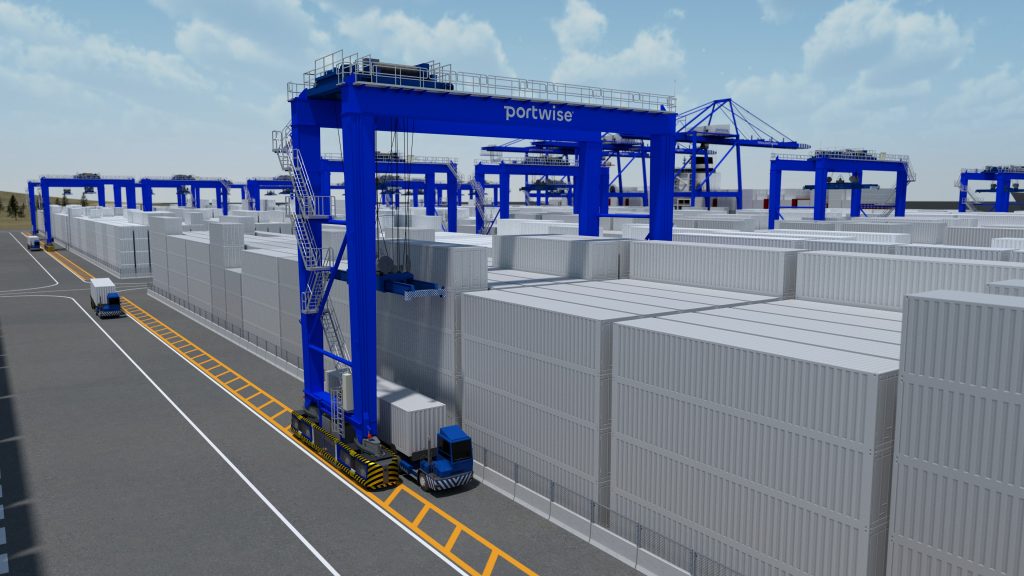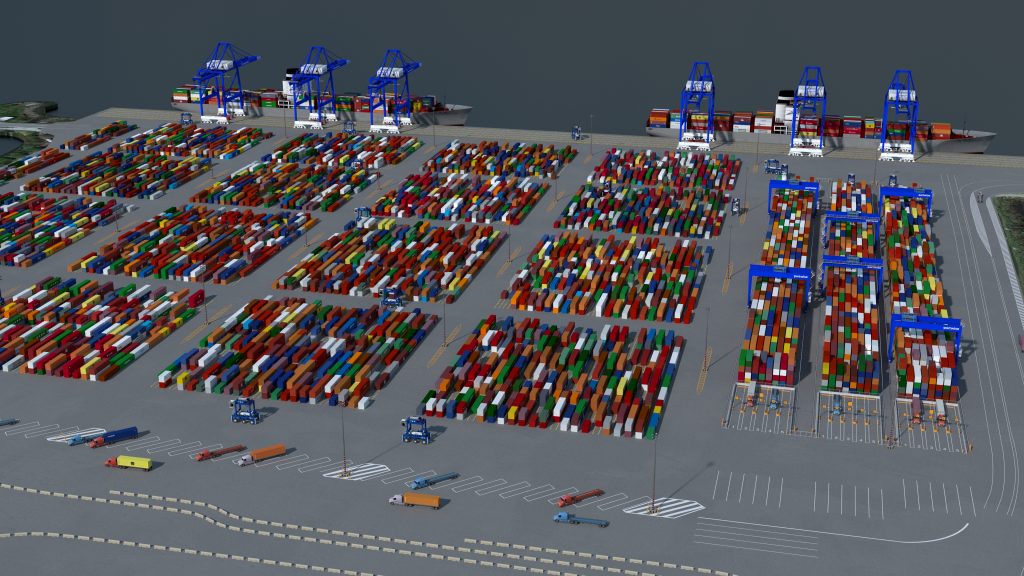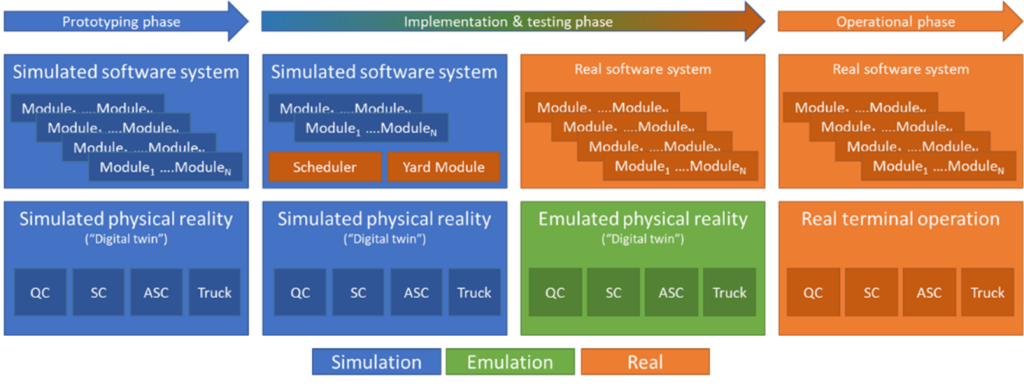High-Performance and efficiency in automated container terminals: planning to execution
The drive for automation is ramping up with brownfield conversions
As container terminals worldwide continue to face labour shortages, increasing pressure to improve efficiency, and the need to enhance safety, automation has emerged as a powerful solution.
There are currently many terminals not starting from scratch but instead focusing on automating existing operations. The challenge, however, is not just adopting new technology, but effectively integrating it into an existing, often complex, operation. Figure 1 shows an example of automation in current stacking and transport equipment.
Brownfield automation offers clear benefits. It enables terminals to increase throughput without expanding physical infrastructure. Automation facilitates 24/7 operations, enhances safety, and reduces labour dependency. However, the transition from manual to automated operations is far from straightforward. The complexity of working within an established terminal layout whilst transitioning to automated workflows, requires a careful, step-by-step approach.
This process involves addressing several key factors, such as adapting existing workflows to accommodate automated systems and aligning automation with current operational practices. The interaction between operators and the systems controlling automation is paramount here. Moreover, as terminals ramp up their automation efforts, it’s essential to set realistic expectations for short-term outcomes while positioning for long-term success.
In this paper, we will explore push for automation in container terminals, the unique challenges it presents, and the strategies needed to achieve high-performance and efficiency in automated container terminals.

Figure 1: Autonomous terminal trucks in an RTG operation as example of a brownfield transition (concept example illustration)
Challenges faced in automated terminals
Transitioning from manual to automated systems is rarely seamless. In brownfield environments, the early phases of automation often create a hybrid setup—where some operations remain manual while others are automated. This mixed approach can lead to significant coordination and integration challenges.
Key challenges of implementing automation in container terminals include:
- Integration Complexity: Aligning automated systems with existing manual processes often leads to communication issues between suppliers, operations, IT, and project teams. This can result in inefficiencies due to the coexistence of disparate workflows.
- Technological Hurdles: System compatibility, equipment calibration, and software integration issues can further complicate the transition.
- Employee Adaptation and acceptance: Operators accustomed to manual systems must quickly adapt to new technologies. If the learning curve is not managed with proper training, it can cause slowdowns and reduced productivity.
- Insufficient Testing and Calibration: Inadequate pre-launch testing, rushed implementations due to time pressures, and incomplete understanding of functional specifications can all contribute to underperformance.
- Fragmented Design: When control system components and equipment are developed through ad hoc negotiations rather than through a rational, holistic design, the resulting fragmentation can lead to sub-optimal performance.
- Misaligned Objectives: A gap often exists between strategic targets (such as throughput volumes and vessel service times) and operational targets (such as quay crane productivity and truck service times). Without clear process control tools and performance insight, managing these differences becomes even more challenging.
These challenges, if not addressed, can lead to system failures, prolonged downtimes, budget overruns, and project delays. Therefore, effective risk mitigation and a well-planned implementation process are critical for success.
Key strategies for high-performance and efficient automated terminal operation
To ensure a successful go-live and unlock the full potential of automation in a terminal, several critical strategies must be applied, which can be segmented into:
- Design
- Implementation
- Optimisation
Design terminal for high-performance and efficient operation and quantify performance targets
A high-performance terminal operation begins with a comprehensive, holistic design. The terminal layout and operational flow must be optimised for efficiency, addressing both current needs and future scalability. This approach involves careful planning of traffic flows, strategic placement of equipment, and minimising bottlenecks to ensure seamless operations.
For greenfield terminals, the process starts with a blank canvas, allowing all infrastructural developments to be planned with performance as one of the primary objectives. In contrast, brownfield terminals must work within the constraints of an existing layout, where infrastructural changes are to be kept to a minimum. A detailed assessment is essential to determine what modifications are feasible in brownfields environments and how to maintain, or ideally improve, performance compared to the current operation.
Based on this high-performance design, realistic performance targets should be established and quantified using detailed simulations and analytical tools. This ensures that the technical requirements align with the operational goals, providing a clear benchmark for success.
Design a functional blueprint of terminal processes
Before diving into the technical details, it’s essential to map out all terminal processes from a functional perspective. A well-defined functional design ensures that automation aligns with real-world operational needs, reducing the risk of sub-optimisation or gaps between design and actual operations. Critical in this step is defining how these functionalities will be mapped in the software architecture.
Translate the functional design into technical and technology requirements
The functional blueprint must be translated into specific technical requirements for software, equipment, and infrastructure. This includes defining how different system components, such as control systems, automated vehicles, and cranes, will interface and communicate. It is crucial to consider not just the ‘happy flow’ of the terminal, but also the exceptional cases—both major and minor—which can be incorporated into automated processes to minimise operator input during operation. Excessive operator input can drastically reduce overall system performance from what was envisioned during the design phase. It is critical in this phase to look at performance-enhancing functionalities to ensure they deliver the targeted results before go-live.
Create a constructive ramp-up approach: start small and expand
A phased approach to ramping up automation is essential to minimise risks during go-live. Start with a smaller, controlled operation to refine and improve processes before expanding. This approach helps address both the terminal’s physical limitations and process testing, which can be done in a lab or live environment. For example, starting with a simple flow such as 40’ container discharge helps identify whether the systems work and interact as intended and designed. Figure 2 shows a physical representation of this ramp-up approach without ongoing construction works. This iterative approach allows the project team to address challenges early while focusing on the key performance metrics, ensuring that all suppliers are on board with the approach before contract signature.

Figure 2: Ramping automation in a transition from straddle carrier operation to automated stacking crane operation
Testing should have started yesterday
Early and comprehensive testing is essential. Delays in testing can cause significant issues during go-live. Testing must be iterative and initiated as early as possible, broken into distinct phases:
- Performance and Functional Benchmarking via Simulation: Use simulation models to establish baseline metrics and validate key functionalities.
- Individual Supplier Functional Labs: Test each supplier’s components in a controlled lab to ensure they meet operational criteria independently.
- Individual Supplier Performance Labs: Validate each component under expected conditions to meet performance benchmarks.
- Integrated Functional Lab (Emulation): Test the interaction between different systems in an emulated environment to confirm that workflows operate as designed.
- Integrated Performance Testing (Lab and live): Finally, conduct comprehensive testing in an environment that closely mirrors real-world operations. This step is crucial for identifying issues that arise only when systems work together.
This structured testing methodology allows for the isolation of supplier-specific issues and simplifies bug identification. Figure 3 illustrates this process from simulation to live testing. Figure 4 shows how a Digital Twin can be used throughout the container terminal’s lifecycle. A similar testing approach should be applied with live equipment, ideally in a controlled section of the terminal to simulate near-live conditions before full-scale deployment.

Figure 3. Four phases of software development cycle from prototyping, to testing, to live operations
Suppliers are part of your performance and optimisation trajectory
Automation doesn’t end with the delivery of equipment or software. Suppliers must remain actively involved in the performance optimisation trajectory, as they are crucial in fine-tuning the automation system. The integration between equipment and control systems is often complex, therefore ongoing collaboration with suppliers helps address issues and ensures the system meets performance expectations.

Figure 4: A Digital Twin used throughout the lifecycle of container terminal operation: Simulation – Functional testing – Performance testing – Optimisation
Training operators should be done during the project, not at handover
Operators are key to a smooth go-live. Their training should start early in the project. Involving them from the start allows them to become familiar with the new systems and provides opportunities for feedback on operational challenges. By the time go-live happens, operators should be proficient and comfortable with the automated systems, bridging the gap between technical and human components.
Continuous improvement is mandatory, not optional.
Once the terminal is live, continuous improvement is essential to maintain performance. Post-commissioning activities are often overlooked as the project finishes. Therefore, continuous monitoring and improvement should be embedded into the operational strategy from the start. Regular reviews and adjustments based on real-time data ensure the terminal remains efficient and adaptable to changing conditions.
Business Intelligence is your friend
Data-driven insights are invaluable for optimising terminal performance. Business Intelligence tools can help identify inefficiencies, track progress, and provide actionable insights to support decision-making. Integrated performance analysis tools, as previously mentioned, are crucial in bridging the gap between strategic targets and day-to-day operations, ensuring peak performance over the long term.
Conclusion
Automation is increasingly recognised as a transformative solution for container terminals, especially within brownfield environments. While the benefits—higher throughput, enhanced safety, and reduced labour dependency—are significant, the road to successful implementation is fraught with challenges.
During the implementation phase, terminals must manage the complexities of integrating automated systems into existing frameworks. However, by employing strategies such as phased rollouts, rigorous testing, proactive training, and continuous improvement, these obstacles can be overcome.
Ultimately, success lies in setting realistic expectations, carefully managing the transition, and maintaining a focus on long-term operational excellence. With proper planning and execution, terminals can fully capitalise on the benefits of automation, driving improved efficiency and competitiveness well into the future.
Talk to one of our terminal experts and let’s see if our Automation Consulting team can help you transforming design concepts into fully operational and efficient automated terminals. At Portwise, we’ve helped leading container terminals in over 80 countries become more efficient, better optimized, more sustainable and highly automated container terminals. Let Portwise help you, too.
About the authors
Kaj de Groot works as Director of Automation Projects at Portwise. He has worked in the ports and terminals field for about 10 years and has been involved in many different brownfield terminal design and automation transition projects.
Yvo Saanen works as Managing Director at Portwise. As founder of TBA and Portwise, he has worked in logistic optimisation for more than 25 years. He holds a PhD in the design of automated terminals. He lectures about simulation and optimisation at various universities.
This article has been published in PTI Journal Edition 149.